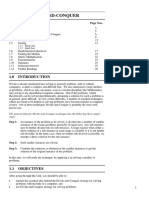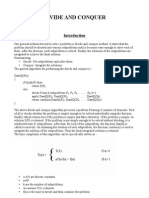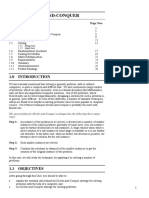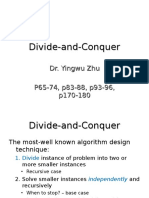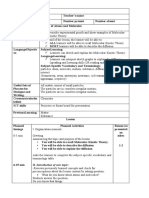0 ratings0% found this document useful (0 votes)
13 viewsDivide and Conquer Algorithm
Dive and Conquer Algorithm
Uploaded by
ganesangCopyright
© © All Rights Reserved
Available Formats
Download as DOCX, PDF, TXT or read online on Scribd
0 ratings0% found this document useful (0 votes)
13 viewsDivide and Conquer Algorithm
Dive and Conquer Algorithm
Uploaded by
ganesangCopyright
© © All Rights Reserved
Available Formats
Download as DOCX, PDF, TXT or read online on Scribd
You are on page 1/ 3
Divide and Conquer Algorithm
Divide and Conquer Algorithm is a problem-solving technique used to solve problems by
dividing the main problem into subproblems, solving them individually and then merging
them to find solution to the original problem. In this article, we are going to discuss how
Divide and Conquer Algorithm is helpful and how we can use it to solve problems.
Divide and Conquer Algorithm involves breaking a larger problem into smaller
subproblems, solving them independently, and then combining their solutions to solve the
original problem. The basic idea is to recursively divide the problem into smaller
subproblems until they become simple enough to be solved directly. Once the solutions to
the subproblems are obtained, they are then combined to produce the overall solution.
1. Divide:
Break down the original problem into smaller subproblems.
Each subproblem should represent a part of the overall problem.
The goal is to divide the problem until no further division is possible.
2. Conquer:
Solve each of the smaller subproblems individually.
If a subproblem is small enough (often referred to as the “base case”), we solve it
directly without further recursion.
The goal is to find solutions for these subproblems independently.
3. Merge:
Combine the sub-problems to get the final solution of the whole problem.
Once the smaller subproblems are solved, we recursively combine their solutions to get
the solution of larger problem.
The goal is to formulate a solution for the original problem by merging the results from
the subproblems.
Characteristics of Divide and Conquer Algorithm:
Divide and Conquer Algorithm involves breaking down a problem into smaller, more
manageable parts, solving each part individually, and then combining the solutions to solve
the original problem. The characteristics of Divide and Conquer Algorithm are:
Dividing the Problem: The first step is to break the problem into smaller, more
manageable subproblems. This division can be done recursively until the subproblems
become simple enough to solve directly.
Independence of Subproblems: Each subproblem should be independent of the others,
meaning that solving one subproblem does not depend on the solution of another. This
allows for parallel processing or concurrent execution of subproblems, which can lead
to efficiency gains.
Conquering Each Subproblem: Once divided, the subproblems are solved
individually. This may involve applying the same divide and conquer approach
recursively until the subproblems become simple enough to solve directly, or it may
involve applying a different algorithm or technique.
Combining Solutions: After solving the subproblems, their solutions are combined to
obtain the solution to the original problem. This combination step should be relatively
efficient and straightforward, as the solutions to the subproblems should be designed to
fit together seamlessly.
Examples of Divide and Conquer Algorithm:
1. Finding the maximum element in the array:
We can use Divide and Conquer Algorithm to find the maximum element in the array by
dividing the array into two equal sized subarrays, finding the maximum of those two
individual halves by again dividing them into two smaller halves. This is done till we reach
subarrays of size 1. After reaching the elements, we return the maximum element and
combine the subarrays by returning the maximum in each subarray.
C++JavaPython3C#JavaScript
// function to find the maximum no.
// in a given array.
int findMax(int a[], int lo, int hi)
{
// If lo becomes greater than hi, then return minimum
// integer possible
if (lo > hi)
return INT_MIN;
// If the subarray has only one element, return the
// element
if (lo == hi)
return a[lo];
int mid = (lo + hi) / 2;
// Get the maximum element from the left half
int leftMax = findMax(a, lo, mid);
// Get the maximum element from the right half
int rightMax = findMax(a, mid + 1, hi);
// Return the maximum element from the left and right
// half
return max(leftMax, rightMax);
}
2. Finding the minimum element in the array:
Similarly, we can use Divide and Conquer Algorithm to find the minimum element in the
array by dividing the array into two equal sized subarrays, finding the minimum of those
two individual halves by again dividing them into two smaller halves. This is done till we
reach subarrays of size 1. After reaching the elements, we return the minimum element and
combine the subarrays by returning the minimum in each subarray.
3. Merge Sort:
We can use Divide and Conquer Algorithm to sort the array in ascending or descending
order by dividing the array into smaller subarrays, sorting the smaller subarrays and then
merging the sorted arrays to sort the original array.
Complexity Analysis of Divide and Conquer Algorithm:
T(n) = aT(n/b) + f(n), where n = size of input a = number of subproblems in the recursion
n/b = size of each subproblem. All subproblems are assumed to have the same size. f(n) =
cost of the work done outside the recursive call, which includes the cost of dividing the
problem and cost of merging the solutions
Applications of Divide and Conquer Algorithm:
The following are some standard algorithms that follow Divide and Conquer algorithm:
Quicksort is a sorting algorithm that picks a pivot element and rearranges the array
elements so that all elements smaller than the picked pivot element move to the left side
of the pivot, and all greater elements move to the right side. Finally, the algorithm
recursively sorts the subarrays on the left and right of the pivot element.
Merge Sort is also a sorting algorithm. The algorithm divides the array into two halves,
recursively sorts them, and finally merges the two sorted halves.
Closest Pair of Points The problem is to find the closest pair of points in a set of points
in the x-y plane. The problem can be solved in O(n^2) time by calculating the distances
of every pair of points and comparing the distances to find the minimum. The Divide
and Conquer algorithm solves the problem in O(N log N) time.
Strassen’s Algorithm is an efficient algorithm to multiply two matrices. A simple
method to multiply two matrices needs 3 nested loops and is O(n^3). Strassen’s
algorithm multiplies two matrices in O(n^2.8974) time.
Cooley–Tukey Fast Fourier Transform (FFT) algorithm is the most common
algorithm for FFT. It is a divide and conquer algorithm which works in O(N log N)
time.
Karatsuba algorithm for fast multiplication does the multiplication of two binary
strings in O(n1.59) where n is the length of binary string.
Advantages of Divide and Conquer Algorithm:
Solving difficult problems: Divide and conquer technique is a tool for solving difficult
problems conceptually. e.g. Tower of Hanoi puzzle. It requires a way of breaking the
problem into sub-problems, and solving all of them as an individual cases and then
combining sub- problems to the original problem.
Algorithm efficiency: The divide-and-conquer algorithm often helps in the discovery
of efficient algorithms. It is the key to algorithms like Quick Sort and Merge Sort, and
fast Fourier transforms.
Parallelism: Normally Divide and Conquer algorithms are used in multi-processor
machines having shared-memory systems where the communication of data between
processors does not need to be planned in advance, because distinct sub-problems can
be executed on different processors.
Memory access: These algorithms naturally make an efficient use of memory caches.
Since the subproblems are small enough to be solved in cache without using the main
memory that is slower one. Any algorithm that uses cache efficiently is called cache
oblivious.
Disadvantages of Divide and Conquer Algorithm:
Overhead: The process of dividing the problem into subproblems and then combining
the solutions can require additional time and resources. This overhead can be significant
for problems that are already relatively small or that have a simple solution.
Complexity: Dividing a problem into smaller subproblems can increase the complexity
of the overall solution. This is particularly true when the subproblems are
interdependent and must be solved in a specific order.
Difficulty of implementation: Some problems are difficult to divide into smaller
subproblems or require a complex algorithm to do so. In these cases, it can be
challenging to implement a divide and conquer solution.
Memory limitations: When working with large data sets, the memory requirements for
storing the intermediate results of the subproblems can become a limiting factor.
You might also like
- Component Diagnostics: E1 - Engine Control Unit: ECU Pin and PlugNo ratings yetComponent Diagnostics: E1 - Engine Control Unit: ECU Pin and Plug9 pages
- Apex Institute of Technology Department of Computer Science & EngineeringNo ratings yetApex Institute of Technology Department of Computer Science & Engineering10 pages
- Unit 2 Divide and Conquer Approach: Structure Page NosNo ratings yetUnit 2 Divide and Conquer Approach: Structure Page Nos40 pages
- Algorithm Pattern - DivideAndConquerCMP422No ratings yetAlgorithm Pattern - DivideAndConquerCMP42221 pages
- DAA Divide and Conquer Introduction - JavatpointNo ratings yetDAA Divide and Conquer Introduction - Javatpoint14 pages
- Unit 1 Divide-And-Conquer: Structure Page NosNo ratings yetUnit 1 Divide-And-Conquer: Structure Page Nos55 pages
- Unit2Part2DivideandConquerApproachpptx 2024 09 11 16 11 57No ratings yetUnit2Part2DivideandConquerApproachpptx 2024 09 11 16 11 5732 pages
- 2 Divide and Conquer - Finding Min and MaxNo ratings yet2 Divide and Conquer - Finding Min and Max45 pages
- General Method - Binary Search - Finding The Maximum and Minimum - Merge Sort - Quick Sort - Selection Sort - Strassen's Matrix MultiplicationsNo ratings yetGeneral Method - Binary Search - Finding The Maximum and Minimum - Merge Sort - Quick Sort - Selection Sort - Strassen's Matrix Multiplications14 pages
- vision_cs_2023_algorithm_chapter_3_divide_and_conquer_21No ratings yetvision_cs_2023_algorithm_chapter_3_divide_and_conquer_2121 pages
- Divide and Conquer: Analysis of AlgorithmsNo ratings yetDivide and Conquer: Analysis of Algorithms11 pages
- Algorithm Design Techniques Algorithm Design TechniquesNo ratings yetAlgorithm Design Techniques Algorithm Design Techniques45 pages
- UML 2 0 in a Nutshell 1st ed Edition Dan Pilone - The full ebook version is available, download now to explore100% (2)UML 2 0 in a Nutshell 1st ed Edition Dan Pilone - The full ebook version is available, download now to explore57 pages
- Session 2 Understanding The Role of The PPST in RPMSNo ratings yetSession 2 Understanding The Role of The PPST in RPMS22 pages
- Instruction Sheet: VIQUA UV Lamp and Quartz Sleeve ReplacementNo ratings yetInstruction Sheet: VIQUA UV Lamp and Quartz Sleeve Replacement5 pages
- Mitsubishi Electric Heat Pump Parts Indoor MSZ-GE22-50VA-A1 PDFNo ratings yetMitsubishi Electric Heat Pump Parts Indoor MSZ-GE22-50VA-A1 PDF8 pages
- Proposal Sponsorship Xendit Conference 2024No ratings yetProposal Sponsorship Xendit Conference 202430 pages
- 2nd Lecture On Skeletal Muscle Physiology by Dr. Mudassar Ali Roomi100% (1)2nd Lecture On Skeletal Muscle Physiology by Dr. Mudassar Ali Roomi29 pages
- A fully digital approach to replicate peri-implant soft tissue contours and emergence profile in the esthetic zoneNo ratings yetA fully digital approach to replicate peri-implant soft tissue contours and emergence profile in the esthetic zone5 pages


















